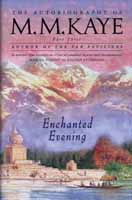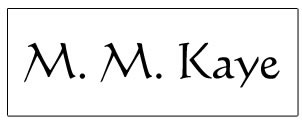Reviews for 'ENCHANTED EVENING'
 This third volume of Mollie Kaye's wonderful autobiography continues the story of her lifelong love affair with India, described so vividly in The Sun in the Morning and Golden Afternoon. Enchanted Evening, however, begins in 1932 with Mollie, aged twenty-four, being temporarily torn away from her beloved India as her father's job forces them to live in China. 384 pages | Published Nov 30 2000.
This third volume of Mollie Kaye's wonderful autobiography continues the story of her lifelong love affair with India, described so vividly in The Sun in the Morning and Golden Afternoon. Enchanted Evening, however, begins in 1932 with Mollie, aged twenty-four, being temporarily torn away from her beloved India as her father's job forces them to live in China. 384 pages | Published Nov 30 2000.
Here are some reviews:
* * *
'Turning to M M Kaye's Enchanted Evening, volume three of her autobiography, means entering another world. It is the world of 'gels', gorgeous locations, ruling-class nick-names and the Raj - in short, the backdrop to Kaye's The Far Pavilions. This is a delicious account in dashing, slightly breathless prose, of Kaye's transition from idyllic childhood and adolescence in India to a more testing family stay in China, and finally the discovery of her writing gift. She also loses her father, Sir Cecil Kaye, aka darling, Tacklow, and this episode, followed by her mother's inconsolable grief, forms one of the most affecting passages of the book.
The style is very readable. Kaye learnt early on what readers wanted. After working with the Chelsea Illustrators in London during the 1930s, she needed to supplement her allowance and decided to write the kind of novel she had been reading at the rate of six a week. The result, a 'thriller-cum-romance' entitled 'Six Bars at Seven', was accepted, published and made her more than £50.
The romance side is important and is the key to her personality. Kaye turned down many suitors because they did not fit in with her view of true love. There is a terrific moment when her sister-in-law, the mis-named Joy, tells her she had better hurry up, having been part of the 'fishing fleet' for too many seasons. Yet Kaye finally meets her man, Major Goff Hamilton. "I can still see him clearly as he was... A tall young man with an engaging grin and eyes the exact shade of the rather battered green port-pie hat that he had forgotten to remove.'
The book contains other gems: meeting Somerset Maugham, spending an idyllic time in the Andamans, hearing of the outbreak of war (which seems distant) in India; but the focus is strictly personal. I can't wait for the next volume.' THE SUNDAY TIMES (culture section) - 7 NOVEMBER 1999
* * *
This is the third volume in the autobiography of the popular author of such classic novels as The Far Pavilions and Shadow of the Moon. While it would help to read the first two volumes (The Sun in the Morning [1990] and Golden Afternoon [1998]), before tackling this one, it's not essential. Kaye is such a good storyteller, and her memories are so rich in detail, that the individual volumes of her saga can stand on their own. This instalment shows how Kaye became a writer and takes us from China to India to London in the years between the two world wars. Kaye remembers this period of her life fondly, almost (in places) wistfully, and she writes about it in a pleasant, friendly style that is utterly ingratiating. Fans of writers' memoirs may wish this one had more nuts-and-bolts information about being a writer, but this is a minor quibble. Readers who have enjoyed the first two volumes of Kaye's life story, or have read and re-read her novels, will be enchanted. David Pitt, © American Library Association. All rights reserved
* * *
The third volume of M.M. Kaye's memoirs continues the story of her life in the engagingly chatty style that is familiar from The Sun in the Morning and Golden Afternoon. As this volume begins, Kaye is a young woman in her 20s, apprehensively en route to China in the spring of 1932. She would have preferred to remain in India, her childhood home (and the setting, many years later, for her bestselling novel The Far Pavilions), but her beloved father, who has been dismissed unfairly from the British colonial service, wants to retire in China. Kaye's account of the family's sojourn is colourful and often quite funny, but the mood darkens when they return to India for younger sister Bet's wedding and their father dies shortly thereafter. Kaye goes to England, planning to support herself as an illustrator, but stumbles instead into a career writing mysteries and children's books. The self-effacing author presents this turn of events as a simple stroke of luck, and devotes most of her text to amusing anecdotes and evocative descriptions of landscape, particularly after royalty payments enable her to return happily to India. In the privileged British Raj, politics hardly impinge until World War II begins in 1939, and this ill wind blows good toward our redoubtable heroine, who meets Mr. Right in the shape of an Indian Army officer who is escaping a bad marriage. Even here, Kaye is oh-so-English in her assertion that Lieutenant Godfrey John Hamilton was "only too ready to fall into the arms of almost any unattached woman.... I can only be profoundly and eternally grateful that she happened to be me." The warm humanism and ready wit that are displayed throughout these charming reminiscences will prompt most readers to feel that Lieutenant Hamilton was the lucky one. Wendy Smith, Amazon.com
